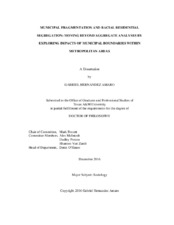| dc.contributor.advisor | Fossett, Mark | |
| dc.creator | Amaro, Gabriel Hernandez | |
| dc.date.accessioned | 2017-03-02T16:50:55Z | |
| dc.date.available | 2018-12-01T07:20:27Z | |
| dc.date.created | 2016-12 | |
| dc.date.issued | 2016-12-06 | |
| dc.date.submitted | December 2016 | |
| dc.identifier.uri | https://hdl.handle.net/1969.1/159089 | |
| dc.description.abstract | This dissertation study tested the hypothesis that greater political fragmentation in a metropolitan area increases the degree of residential segregation between non-Hispanic whites and non-Hispanic blacks. The questions posed in this study is: (1) Do boundaries capture segregation because they are drawn and redrawn over time to reflect shifts in population distribution or do boundaries capture segregation because they represent social and physical barriers that prevent groups from entering? (2) Do administrative and political boundaries capture segregation better than similarly sized arbitrarily aggregated areas?
I begin examining the relationship between political fragmentation and residential segregation at the aggregate level across U.S. metropolitan areas by calculating measures of fragmentation and segregation for each city and then examining their covariation across metropolitan areas. I follow this with fractional logit regression analyses comparing the results using alternative measures of fragmentation and segregation.
I contribute to and extend the literature on this topic by examining the relationship more closely using methods of decomposition. First, I decompose segregation over multiple nested spatial levels - specifically, census blocks within block groups, block groups within census tracts, and census tracts within places and examine their between and within component variation. Utilizing the contribution to the segregation score at each level, I regress the results with measures of fragmentation to determine whether the geographic unit used in assessing segregation affects the extent to which the two are related.
Lastly, I compare segregation scores captured using arbitrarily drawn places with segregation scores captured using observed places. I conclude that a relationship does exist between political fragmentation and residential segregation. I also find that political fragmentation’s impact is greatest at the largest and most meaningful cities in the U.S. The multiple analyses implemented in this dissertation allow the findings to be deemed robust and to conclude with confidence that this relationship is real. | en |
| dc.format.mimetype | application/pdf | |
| dc.language.iso | en | |
| dc.subject | residential segregation | en |
| dc.subject | demography | en |
| dc.subject | political fragmentation | en |
| dc.subject | inequality | en |
| dc.subject | municipal boundary | en |
| dc.subject | decomposition | en |
| dc.subject | decomposition regression | en |
| dc.subject | fractional logit regression | en |
| dc.title | Municipal Fragmetation and Racial Residential Segregation: Moving Beyond Aggregate Analyses by Exploring Impacts of Municipal Boundaries within Metropolitan Areas | en |
| dc.type | Thesis | en |
| thesis.degree.department | Sociology | en |
| thesis.degree.discipline | Sociology | en |
| thesis.degree.grantor | Texas A & M University | en |
| thesis.degree.name | Doctor of Philosophy | en |
| thesis.degree.level | Doctoral | en |
| dc.contributor.committeeMember | Poston, Dudley | |
| dc.contributor.committeeMember | McIntosh, Alex | |
| dc.contributor.committeeMember | Van Zandt, Shannon | |
| dc.type.material | text | en |
| dc.date.updated | 2017-03-02T16:50:56Z | |
| local.embargo.terms | 2018-12-01 | |
| local.etdauthor.orcid | 0000-0001-5437-1737 | |


